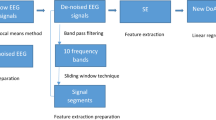Abstract
One avenue of research for a reliable monitor of anesthetic efficacy has been the computer-processed electroencephalogram (EEG), investigation being centered around derivatives of the power spectrum. Schüttler [1] has used the median frequency to control drug administration for closed loop anesthesia. However, the ability of power spectral derivatives to act as precise indices of anesthetic efficacy has not been consistently demonstrated. Rampil [2] showed that the 95% spectral edge may predict a hypertensive response to laryngoscopy, whereas Mills [3] was unable to correlate EEG and hemodynamic changes during induction, intubation, and skin incision and Dwyer [4] showed no correlation between movement at skin incision and several EEG power spectral derivatives during 1.0 MAC (minimum alveolar concentration to prevent movement at incision in 50% of patients) isoflurane anesthesia.
Access this chapter
Tax calculation will be finalised at checkout
Purchases are for personal use only
Preview
Unable to display preview. Download preview PDF.
Similar content being viewed by others
References
Schüttler J, Kloos S, Ihmsem H, Schwilden H (1992) Clinical evaluation of a closed- loop dosing device for intravenous anesthesia based on EEG depth of anesthesia monitoring. Anesthesiology 77:A501
Rampil I J, Matteo RS (1987) Changes in EEG spectral edge frequency correlate with the hemodynamic response to laryngoscopy and intubation. Anesthesiology 67:139–142
Mills AK, Ghouri A, Monk TG, White PF (1990) Lack of correlation between electroencephalographic and hemodynamic changes during general anesthesia. Anesth Analg 70:S268
Dwyer R, Rampil I, Eger II EI, Bennett HL (1991) The EEG does not predict movement in response to surgical incision at 1.0 MAC isoflurane. Anesthesiology 75:A1025
Dumermuth G, Huber PJ, Kleiner B, Gasser TH (1971) Analysis of the interrelations between frequency bands of the EEG by means of the bispectrum. A preliminary study. Electroencephalogr Clin Neurophysiol 31:137–148
Barnett TP, Johnson LC, Hicks N, Nute C (1971) Bispectral analysis of electroencephalogram signals during waking and sleeping. Science 172:401–402
Kearse L, Saini V, deBros F, Chamoun N (1991) Bispectral analysis of EEG may predict anesthetic depth during narcotic induction. Anesthesiology 75:A715
Editor information
Editors and Affiliations
Rights and permissions
Copyright information
© 1994 Springer-Verlag Berlin Heidelberg
About this chapter
Cite this chapter
Vernon, J.M., Sebel, P.S., Bowles, S.M., Chamoun, N., Saini, V. (1994). Bispectral Electroencephalogram Analysis for Monitoring Anesthetic Adequacy. In: Schulte am Esch, J., Kochs, E. (eds) Central Nervous System Monitoring in Anesthesia and Intensive Care. Springer, Berlin, Heidelberg. https://doi.org/10.1007/978-3-642-78441-5_6
Download citation
DOI: https://doi.org/10.1007/978-3-642-78441-5_6
Publisher Name: Springer, Berlin, Heidelberg
Print ISBN: 978-3-642-78443-9
Online ISBN: 978-3-642-78441-5
eBook Packages: Springer Book Archive




